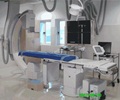A new study has found that even a moderate bulge at the waist could put a person at a greater risk of cardiovascular diseases.
A new study has found that even a moderate bulge at the waist could put a person at a greater risk of cardiovascular diseases.
The research, conducted at the University of Texas Southwestern Medical Center in Dallas, suggests that accumulating several inches to the waist, even if body weight still falls within a normal range, noticeably boosts the risk of unhealthy plaque build-up in the arteries of the heart and the rest of the body."In our thirties and forties, we often gain three to four inches in the midsection. It's a day-to-day, meal-to-meal battle, but it's worth fighting. Even a small pot belly puts us at higher risk when compared to a flat tummy," said James A. de Lemos, M.D., F.A.C.C., a professor of medicine and director of the Coronary Care Unit at the University of Texas Southwestern Medical Center.
For the study, Dr. de Lemos and his colleagues assesed data from the ongoing Dallas Heart Study, which is evaluating risk factors for heart disease in a large, multiethnic, urban population with a median age of 45. The new substudy focused on a group of 2,744 participants who had noninvasive imaging tests to look for early signs of plaque build-up in the arteries, which signals an increased risk of developing cardiovascular disease later in life.
Electron-beam computed tomography (EBCT) was used to spot calcium deposits in the arteries of the heart. These deposits point towards the beginning of atherosclerosis, or so-called hardening of the arteries, and can be detected years before a person experiences chest pain or has a heart attack.
Researchers then looked at the relationship between body shape and early signs of arterial disease. They found that the chances of calcium being found in the arteries of the heart grew in direct proportion to increases in the waist-to-hip ratio (WHR).
Additionally, when they divided the WHR into five groups from smallest to largest, they found that people with the largest WHR were nearly twice as likely to have calcium deposits in their coronary arteries as those with the smallest WHR. The likelihood of atherosclerotic plaque in the aorta was three times as high in those with the largest WHR as compared to the smallest.
Advertisement
"Middle-aged spread is not healthy. We don't have to clean our plates. It's better to throw food out than add it to our waists," Dr. de Lemos said.
Advertisement
"The WHR can be easily measured, taking only a few moments and giving more precise information on the presence of coronary artery calcium than BMI or waist circumference. In addition, although BMI is used more often, it does not identify patients with central obesity, which seems to be related to the metabolic syndrome, insulin resistance and abnormal cholesterol levels. However, most important is that other measures of obesity did not discriminate beyond traditional risk factors, whereas WHR did," Dr. Erbel said.
"The results are most astonishing and may be influenced by the age distribution of the study. During life, the likelihood of coronary artery calcium increases more in men than in women. It may be that in an older population, in which the duration of risk factor exposure is longer and the likelihood of coronary artery calcium is higher, the association between obesity-as measured by BMI and waist circumference-and signs of early atherosclerosis is stronger," he added.
The study appears in the August 21, 2007, issue of the Journal of the American College of Cardiology (JACC).
Source-ANI
LIN/J










